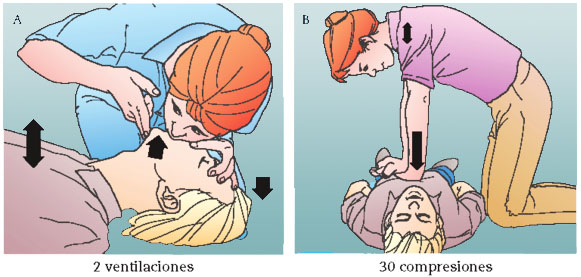Cardiopulmonary resuscitation (CPR)
Before continuing see the notes on the use of this Guide.
Generalities:
Cardiopulmonary or cardiorespiratory resuscitation is applied in case of cardiorespiratory arrest, that is, when the person does not breathe or have a pulse. This maneuver replaces the function of the lungs and the heart allowing a certain amount of oxygen to continue reaching the whole body, particularly the brain, which begins to suffer irreversible damage after a few minutes without oxygen.
Procedure:
- Verify that the person does not breathe by observing their chest and abdomen to try to detect any movement. Check the pulse in the neck or one of the wrists.
- Verify that the airways are not obstructed. If there is obstruction proceed with the Heimlich Maneuver
- Call emergency services or ask someone to do it.
- Begin CPR:
- Mouth to mouth breathing. provide two rescue breaths (air) in the lungs: Tilt the victim's head back slightly and cover his nose. Breathing from mouth to mouth (image A). If it is a child or baby, dose the amount of air that is blowing, since the child's lungs are smaller.
- Heart massage.Make 30 compressions with both arms, placing one hand on another and using the heel of the hand to press on the victim's chest and sinking up to 5 centimeters (image B); trying to keep a rhythm of 100 - 120 compressions per minute (that is, you should do 30 compressions between 30-40 seconds)
- Repeat alternating 2 rescue breaths and 30 compressions until the person breathes again or emergency services arrive. In children and infants the following cycle is applied 2 x 15 x 5. (insulfactions - compressions - insulfactions)

Considerations:
CPR can be applied by two people A and B. Person A providing rescue breaths. Person B doing chest compressions. After 4 cycles, change positions and continue until the person exhibits signs of life or emergency services arrive.
CPR should be avoided or suspended only when:
- There is a legal instruction not to apply CPR on the victim.
- The body shows signs of irreversible death such as rigor mortis, decapitation or lividness in places of decline.
The CPR does not guarantee that the person's life can be saved, but if so it reduces possible damage due to lack of oxygenation.
Causes:
The main causes of a cardiorespiratory arrest can be:
among others.

